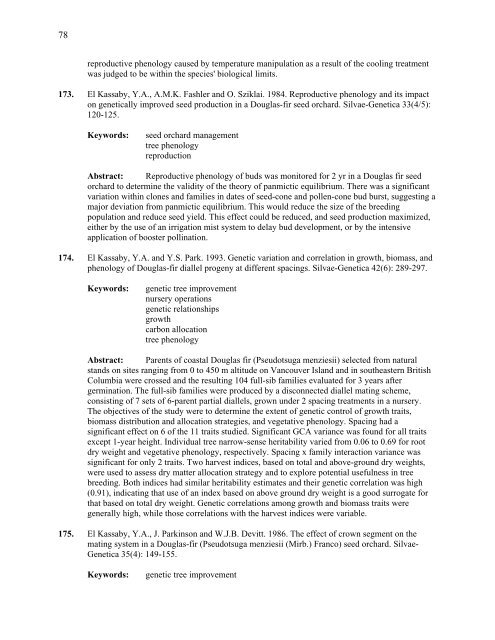IntensIve sIlvIculture - Forest Science Labs - Research Network ...
IntensIve sIlvIculture - Forest Science Labs - Research Network ...
IntensIve sIlvIculture - Forest Science Labs - Research Network ...
You also want an ePaper? Increase the reach of your titles
YUMPU automatically turns print PDFs into web optimized ePapers that Google loves.
78<br />
reproductive phenology caused by temperature manipulation as a result of the cooling treatment<br />
was judged to be within the species' biological limits.<br />
173. El Kassaby, Y.A., A.M.K. Fashler and O. Sziklai. 1984. Reproductive phenology and its impact<br />
on genetically improved seed production in a Douglas-fir seed orchard. Silvae-Genetica 33(4/5):<br />
120-125.<br />
Keywords: seed orchard management<br />
tree phenology<br />
reproduction<br />
Abstract: Reproductive phenology of buds was monitored for 2 yr in a Douglas fir seed<br />
orchard to determine the validity of the theory of panmictic equilibrium. There was a significant<br />
variation within clones and families in dates of seed-cone and pollen-cone bud burst, suggesting a<br />
major deviation from panmictic equilibrium. This would reduce the size of the breeding<br />
population and reduce seed yield. This effect could be reduced, and seed production maximized,<br />
either by the use of an irrigation mist system to delay bud development, or by the intensive<br />
application of booster pollination.<br />
174. El Kassaby, Y.A. and Y.S. Park. 1993. Genetic variation and correlation in growth, biomass, and<br />
phenology of Douglas-fir diallel progeny at different spacings. Silvae-Genetica 42(6): 289-297.<br />
Keywords: genetic tree improvement<br />
nursery operations<br />
genetic relationships<br />
growth<br />
carbon allocation<br />
tree phenology<br />
Abstract: Parents of coastal Douglas fir (Pseudotsuga menziesii) selected from natural<br />
stands on sites ranging from 0 to 450 m altitude on Vancouver Island and in southeastern British<br />
Columbia were crossed and the resulting 104 full-sib families evaluated for 3 years after<br />
germination. The full-sib families were produced by a disconnected diallel mating scheme,<br />
consisting of 7 sets of 6-parent partial diallels, grown under 2 spacing treatments in a nursery.<br />
The objectives of the study were to determine the extent of genetic control of growth traits,<br />
biomass distribution and allocation strategies, and vegetative phenology. Spacing had a<br />
significant effect on 6 of the 11 traits studied. Significant GCA variance was found for all traits<br />
except 1-year height. Individual tree narrow-sense heritability varied from 0.06 to 0.69 for root<br />
dry weight and vegetative phenology, respectively. Spacing x family interaction variance was<br />
significant for only 2 traits. Two harvest indices, based on total and above-ground dry weights,<br />
were used to assess dry matter allocation strategy and to explore potential usefulness in tree<br />
breeding. Both indices had similar heritability estimates and their genetic correlation was high<br />
(0.91), indicating that use of an index based on above ground dry weight is a good surrogate for<br />
that based on total dry weight. Genetic correlations among growth and biomass traits were<br />
generally high, while those correlations with the harvest indices were variable.<br />
175. El Kassaby, Y.A., J. Parkinson and W.J.B. Devitt. 1986. The effect of crown segment on the<br />
mating system in a Douglas-fir (Pseudotsuga menziesii (Mirb.) Franco) seed orchard. Silvae-<br />
Genetica 35(4): 149-155.<br />
Keywords: genetic tree improvement
















